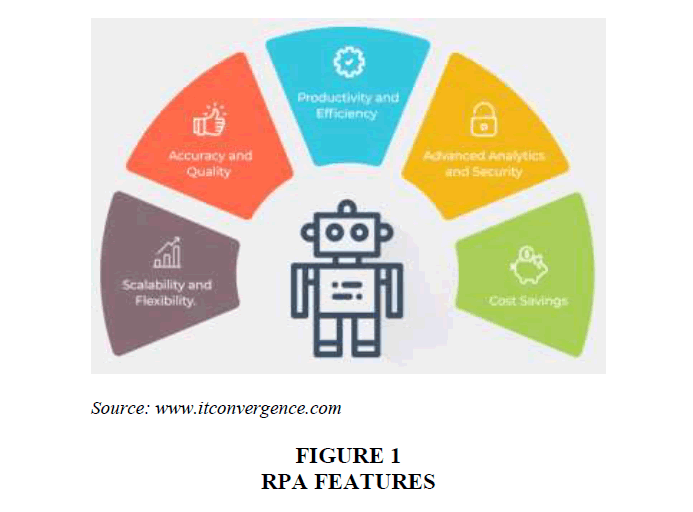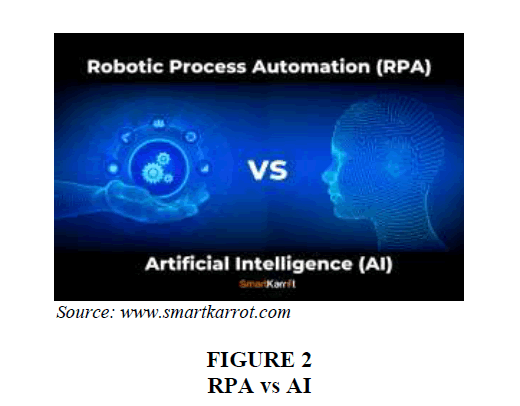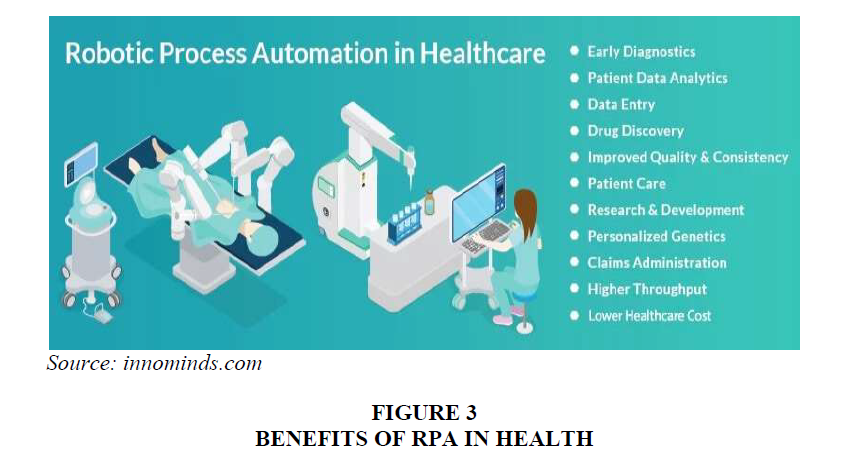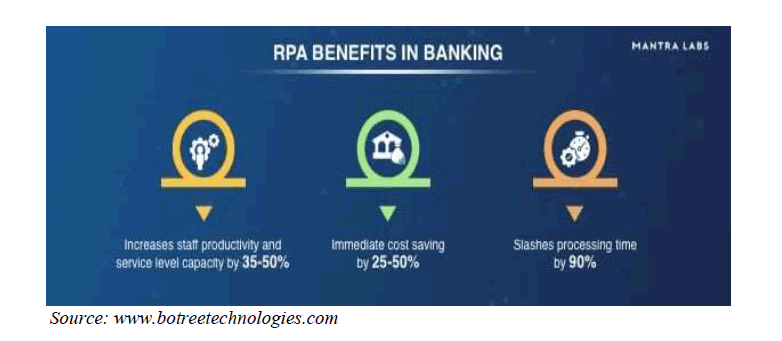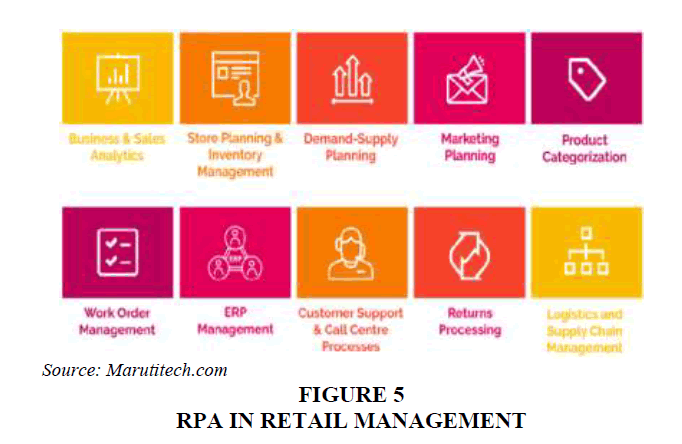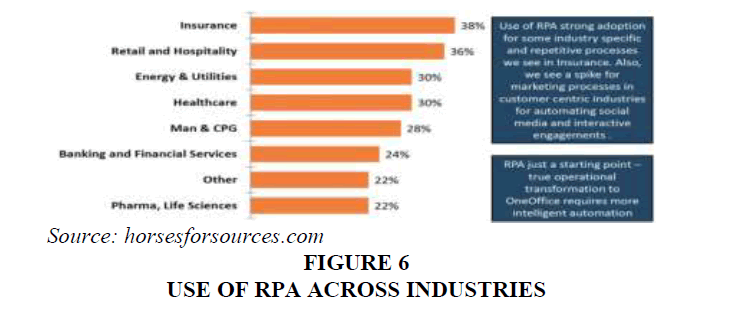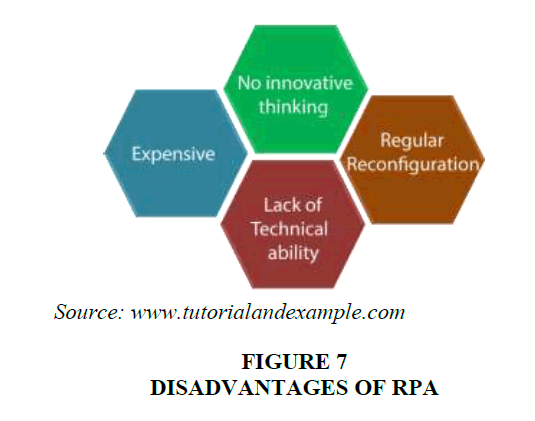Research Article: 2021 Vol: 27 Issue: 3
Robotic Process Automation end from Entrepreneurial Content Editing to Go Live
Apoorva Ganapathy, Adobe Systems
Abstract
The invention of Robotic Process Automation (shortened as RPA) may likely disrupt the normal way of handling mundane and boring repetitive tasks. Robotic automation end to end from content editing to go live allows automation of rule-based jobs in business which are repetitive. These processes and jobs are usually carried out manually by humans. Robotic process automation in businesses is meant to reinvent business roles, such as interpreting job applications, processing transactions, dealing with data, and replying to jobs. The robotic process replaces human workers by carrying out mundane tasks in order of importance. This brings efficiency and better quality of results. The article describes RPA, the meaning, advantages, and how RPA may be utilized for entrepreneurship efficiency. Also, the unique similarities and differences between RPA and Artificial Intelligence.
Keywords
Robotic Automation, CMS, Artificial Intelligence, Automate Industry Software, Entrepreneurship
Introduction
Advancement in technology has led to the use of smart technologies in carrying out tasks and jobs through automated processes. As the world becomes more mechanized and industrialized, it becomes more necessary to automate jobs and tasks for efficiency, reduced cost, and better quality of products. For instance, the production lines created by Henry Ford in 19922 were an industrial engineering process where repetitive tasks were carried out. The introduction of RPA in the manufacturing industries in carrying out complex repetitive tasks. The process of automation in business has not, to a large extent, been implemented fully. Several major companies and enterprises have starter to embrace the idea of RPA in data management and task management. They are blending the automation processes with a mix of machine learning artificial intelligence.
Robot Process Automation
Robotic process automation may seem like a process where real-life moves from office to office and carry out human jobs. Just like watching futuristic movies. In the RPA context, robots are software licenses. Software robots are configured and programmed to perform tasks ordinarily performed by humans in business processes. The application of RPA technology in businesses is aimed at the automation of business processes through structured inputs and business logic. Configured RPA tools enabled a company to detect and decipher applications for transaction processing and activating feedback and interactions between other computer systems (Doewes et al., 2021). RPA may be deployed for different office tasks.
To the Institute of Electrical and Electronics Engineers (IEEE) Standards Association, RPA is programmed software that utilizes rules of business and pre-established activity patterns to carry out the autonomous task with the mixture of tasks, transactions, activities, and processes in a single or multiple disconnected software systems to result in service without human monitoring. The already configured software programs perform jobs ordinarily carried out by humans (Amin & Vadlamudi, 2021). The software may be referred to as robots. To be candid, the use of RPA robots involves the automation of human tasks.
RPA features several distinct elements that differentiate other automation tools from them. RPA and other business process management systems, business reengineering, and so on appear distinct due to their unique characteristics (Donepudi et al., 2020; Zhu et al., 2021).
RPA uses the presentation of software layers to carry out tasks just like humans do. It automates tasks such, sending emails, development of reports, logins, and so on. Stored macros automate certain functions in excel, and they may be likened to RPA. The dividing line between the two of them is that RPA is made to function on almost every available computer or server software after it has been recorded (Ahmed et al., 2021). RPA normally constitutes a record button on the interface. The record button builds a script or a robot after activation as it is used to perform the automated task by users.
The robot can be trained through configuration to go through emails, detect important information, replace data in ERP networks, open pdf, and send messages to particular human supervisors in case of potential errors or detected a crash. Action like this may be managed in real-time by software robots or script designers (Vadlamudi et al., 2021).
The RPA is usually fitted to perform mainly "swivel chair" processes that are processes that require taking data inputs from one set of computers and processing that data (e.g., sending an email) based on existing protocols and then inserting the data into another system.
For instance, a Human Resource expert who is in charge of recruiting new workers for a giant company would have to follow a process for registering the new employees. The process may involve logging on to and logging off a couple of computers to register their data like names, benefits, email, payroll, allocated office, level of authorization, and so on. This process is repeated for all the new employees, which would take a lot of work and energy. However, the workload is reduced greatly with the programming and configuration of RPA software to carry out these functions following the rules and guidelines for admission. The RPA software does the same routine tasks by logging on/off the various systems with its username and password.
When to Use RPA
As the world advances, the need for more automated tools increases with it. The tasks and areas where RPA can be appropriately deployed would also increase. Some tasks fit the features of RPA, and they help identify the appropriate use of RPA also. For example, Processes that straight forward are easily automated. The ambiguous task is not highly encouraged for RPA deployment as robots software needs clear and precise command currently to carry out successfully. In the future, RPA software robots may be able to move past ambiguities to perform tasks with high efficiency. Furthermore, repetitive tasks can greatly benefit from RPA automation software. Tasks such as accounting, auditing, payroll, and data input, and output are usually recurring mundane tasks that may be easily automated. Tasks easy to predict are good candidates for automation (Ahmed et al., 2013). Since the outcomes are predictable, the cost is known. Companies may choose not to automate tasks that may cost a huge amount if there are faults.
According to professional auditing and business process improvement literature, RPA deployment in deployment in businesses can improve scale economies and processes when the process is manual and repetitive. Additionally, where a task requires human judgment or is ambiguous and without a sequence or pattern and occurs infrequently, it becomes inappropriate for RPA. Businesses must focus on a less complex and nonobjective task for RPA implementation.
Artificial Intelligence and Robot Process Automation
Straightforwardly, Robot Process Automation is not Artificial Intelligence, and artificial intelligence is not Robot Process Automation. However, in the future, the connection of the two would lead to endless possibilities for businesses everywhere. With the advancement in technology, it is now possible to add machine and deep learning, image recognition, natural language processing, and other skills, which are components of Artificial Intelligence, into RPA robots software (Vadlamudi, 2021b). These advancements would significantly improve RPA robots by expanding their ability to carry out the cognitive processes that need features like: Understand different types of documents and data. Such as undefined and semi-defined data. Screen visualization, understanding speech, language and having conversations and chatting.
Artificial Intelligence has resulted in several scientific and technological possibilities (Ganapathy, 2015). It has led to a lot of discoveries in automation and how an advanced automation system through the application of RPA robot software. Most businesses are looking for ways to integrate Artificial Intelligence into their system to carry out activities and effectively so. RPA software can be programmed to enable machine learning components in automation processes for analyses and decision making (Vadlamudi, 2021a). The RPA may be utilized by different businesses and organizations for different tasks and functions. A look into how Robot Process Automation may be used by different organizations and institutions include.
RPA in Healthcare System
In the healthcare industry, there are countless situations and areas where the RPA would come in handy (Azad et al., 2021). There are great benefits to the use of RPA robots in healthcare. Best areas for the deployment of RPA include followings:
- Processing payment: the use of RPA in payment processing would reduce the workload and task on staff in the hospital and even pharmacies. Here the payment department of major health care facilities would automate the payment processes using the RPA, which saves time.
- Insurance claim management: there are usually insurance claims disputes between patients and different hospital management. Such claims may be automated by using RPA software bots using the established frameworks and data for collection claims.
- Patient’s registration: RPA has been greatly deployed for patient’s registration in the healthcare industry. This is time-consuming for human workers. RPA is used to register patients and provide the registration form for the registered patient in the shortest time.
Deployment of RPA in the Manufacturing Sector
Like the healthcare industry, RPA may be deployed in numerous tasks in the manufacturing industry. The following are areas where RPA may be effectively deployed in the manufacturing industries:
- Reporting and administrative functions: A major advantage of RPA is its ability to provide accurate data on production reports and also generally a clear picture of the status. It makes administration and production easy by providing accurate information that would help in quick response and efficient decision-making.
- Management of inventory: RPA can be used to manage inventory by automating digitization, paperwork, emails, and check levels of inventory and product demand.
- Material bills: In the manufacturing industry, RPA software robots can automate material bills using data extraction to provide data accuracy, which would significantly reduce errors and issues in transactions.
RPA in the Telecommunication Industry
Cased of the best use of RPA can be observed in the telecom industry. Companies in this sector can deploy Robot Process Automation in the following processes (Paruchuri, 2021). Checking account: postpaid account in the telecom sector needs to be checked. It normally takes manual documentation of processing. Companies can automate this function using RPA.
- Generating reports: reports of issues based on connectivity needs to be generated following the standards of severity and sent to the administrators. These processes are best suited for RPA as it can, through automation, generate the report and send it to the administrators.
- Forwarding simple query: RPA can collect emails sent by third parties, customers, shareholders, and so on and forward the same to the programmed offices or persons using the set parameters.
- Porting number: for customers wishing to port their numbers, the RPA can automate the process easily and efficiently.
RPA in Information Technology
RPA is an advancement in technology, and the technology sector has been impacted greatly by Robotic Process Automation. Here are few examples of the impact of RPA in information technology:
- Installation of tools: Tools installation and downloading processes may be automated. This would, in the long run, save time for another more important task.
- Configuration: the platform for coding is usually configured. RPA can be used through automation for the start-up configuration.
- Testing Automations: the testing of automation processes is one of the best business processes in the technology industry. Manual testing by the user takes time and a lot of actions. The normal testing method may be automated by RPA, which can also run the updates and edit as well. It will allow for quick bug detection and fixing of errors faster than the manual method.
RPA in the Financial World
RPA has changed the banking sector drastically through the automation of various banking processes. The most useful cases in the use of RPA in the bank and financial world are:
- Credit checks: credit checks may be carried out by RPA software bots for a prospective loan to determine whether or not them a qualified for the load as per the set parameters. With RPA automation processes, loan request time has significantly been reduced.
- Entering data: customer data and information were registered manually by bankers the filled documents. By scraping the documents, RPA robots can collect the data from the forms automatically and input it into the bank's system.
- Application Review: various banks have automated credit card processing systems, thereby increasing the speed and response time.
- Taking in customers: bank account opening for customers can be carried out using RPA. The process of onboarding is quite mundane and requires repetitive actions. Robotic Process Automation has been used to undertake this task without stress.
RPA in Customer Service
Customer service can be done using RPA to automate the processes. It can be used to develop and strengthen customers experience and for better customer satisfaction through the following ways:
- Timely replies: customers' issues may be resolved using RPA to sort out common issues and delivering on-time solutions to the issues. For the best result integration with AI would be required.
- Forwarding queries: queries in numerous categories can be sorted out using RPA to apply the set framework and send them to the appropriate department automatically.
- Data sales: RPA can provide data that can help sales representative’s market products to customers thereby saving time.
RPA in Retail Business
The consumer-based industry which is the retail market is fast-paced. This has made the need for tools that would increase efficiency and reduce cost important. RPA can be utilized in the retail industry in the following ways.
- Management of Inventory: RPA can help gather data on commodities and send alerts to the system in case of a shortage.
- Product Rejection: when products are rejected and returned it follows a lot of processes and formalities. The robotic process automation can easily go through sales records in no time to find records of that product.
RPA in Insurance
The insurance, claims have resulted in a lot of complaints. Mostly the time taken to process claims is excruciatingly slow. Here are few examples of how RPA can be utilized by insurance companies.
- Verification of claims: insurance enterprises verify claims using Robotic Process Automation to predefined rules and reduce claims.
- Processing time: processing claims manually takes a lot of time because data would be extracted and then filled into the provided forms. With RPA, the speed is increased and increases customers' experience.
- Renewing premiums: Robotic Process Automation is highly beneficial in renewing premiums in insurance companies. The RPA detects the expiration date and sends notice to the customers with human supervision.
Benefits of RPA
Several benefits result from the use of RPA in businesses. It has been used to improve business efficiently leading to an increase in the productivity level of employees which would invariably cause a positive increase in profit. Some I pioneers are still skeptical about the implementation of RPA in businesses.
Robotic Process Automation as discussed earlier breaks down processes of carrying tasks usually carried out by humans using the set parameters. RPA carries on routine and repetition through automation to relieve staff and human workers from stress. There numerous benefits of using RPA in business. The advancements in technology and development of RPA have made it possible for businesses to adopt the use of RPA to automate tasks. Below are some of the most important benefits of RPA do business. However, there is some indirect but significant use of RPA in businesses. This is because repetitive and mundane tasks distract the workforce from focusing on more important and productive tasks. Automating task would allow businesses to:
- Position the staff to carry out more essential tasks that need human intelligence and subjective knowledge.
- Reduce expenses by replacement of human workers with machines.
- Enhance productivity as the RPA perform jobs fast and efficiently
- Reduce errors.
The Utilization of RPA in Businesses
Enhanced use of Resources: reducing the risk of possible errors in business would make a business enterprise highly efficient in carrying out its operations. As humans perform lots of tasks and office duties, the possibilities of human error resulting from boredom which comes from repeating a particular mundane task. These tasks become less interesting with time therefore lesser and lesser attention would be paid as time goes on. Robotic Process Automation can be used instead of a human in handling this task to reduce the chances of errors. While the human employees would handle more important and interesting tasks that are more time and effort worthy. By enhancing the use of HR, businesses get little resistance from employees who are voted for repetitive tasks when significant tasks are given instead.
Introduction of adaptability and flexibility in processing: RPA tends to bring about flexibility into businesses. The adaptability feature of the Robotic Process Automation systems makes it possible for it to adapt to situations and conditions that are useful to business processes. The adaptability and flexible features allow the RPA to detect tiny changes and adjust accordingly saving the supervisors the trouble of checking for errors. According to research, when workers are required to make little modification to the usual everyday tasks they often forget, this may lead to errors sometimes. RPA is saved on servers in case there is a need for updates, modifications, or changes due to an increase in the initial scope.
Saves costs: The use of Robotic Process Automation in addition to workflow tools would increase the efficiency of businesses. The use of both tools together proves to be a game-changer in business processes as both tools would complement the other (Ganapathy, 2017). The workflow tools will send signals to the RPA which it will act upon and feedback into the workflow tool as data output. The relationship would prove to be cost-effective.
Communication improvement: RPA is better equipped to undertake essential communication processes. This is why businesses must use RPA instead of other document creation instruments. Changes in a particular document can be used by RPA using triggers. These processes and changes can be effected on the whole document thereby reducing the need for a human worker to update or make corrections manually. This feature makes it for users and staff to get new information on time.
Automated triggers and responses: Generally, almost every RPA software is programmed with a scheduling function. This could assist managers in scheduling (semi and fully automated) processes. In the trigger scenario, it is a trigger and response setting. That is the RPA to respond to human activity like a click. In the case of unattended automation, there is no need for action. It can be by a received document or a received mail. It is up to business management to determine processes that should be completely automated and those that should be partly automated using the triggers and response system.
Easy implementation: Robotic Process Automation does not need setting up an application programming interface, this saves substantial cost as well time. RPA uses an in-house Graphic user interface which is built with it. They relatively easy to use and requires little or no expertise. A human operation like keystrokes, clicks, button press, etc can be carried out by RPA using the same user interface.
Workforce empowerment: Research has shown that employees feel positive when their workload is reduced and carried out by a machine. Robots can handle repetitive, boring, tedious tasks (Ganapathy, 2016). This will greatly improve employee satisfaction because they handle more important tasks. Employee satisfaction improves workforce appreciation of their job and the need to stop the jobs are removed. When employees feel appreciated they also feel satisfied with is a game-changer for high morale (Paruchuri, 2019).
Analytics and insights: Using Robotic Process Automation in data management and analytics reduces chances of leakage of data, outdated information, and error-filled analytics. A full picture of company data can be seen using RPA. It would also lead to greater insights that can be acted on with reduced possibilities of errors (Azad et al., 2021). RPA robots conduct greater analysis of data to access data that humans cannot. This entails a massive collection of data with more advanced insights (Paruchuri et al., 2021). This will enable humans to focus on more intricate analysis and in the long-run best decision taking.
Operations without Errors: The use of RPA to run operations enables error operations at a level higher than human employees. This is one of the best advantages that come with the deployment of RPA in operation. Automating different business functions removes mistakes and costly errors. It brings about accuracy and precision in business operations by making repetitive processes free of errors. For instance, when customers' information and data are not misplaced or mistaken, customer service representatives can easily serve customers without difficulty in a relative manner. A minor error on a customer's record can cause a negative experience for customers and ruin a business. With RPA these risks are reduced to the minimum.
Secure business data: For greater security of business data, RPA can be infused with several applications. The connection between RPA and other apps will make sure that customers' applications will not be altered by any robot. With this system in place, the risk of interference from third parties in business place and processes would be reduced (Ahmed, 2020). This is possible as RPA comes with an already defined structure where permissions and guidelines are already set.
Numerous businesses can implement RPA into their system, however, it isn't for every enterprise: However, like most technologies, RPA has been seen as many to reduce employment levels through job elimination. Research has shown that some enterprises have tried to move many workers from RPA applicable jobs to new jobs (Ganapathy, 2021). While the potential job loss for workers may go up to 200 million. That is about 9% of the world's workforce.
Robotic Process Automation fails quite a lot: The crashes usually result in huge data loss. Due to these crashes, several RPA programs have been paused and some enterprises have refused to implement them (Vadlamudi, 2020).
The installation of thousands of RPA software takes quite a long time: Many huge businesses require complex RPA software which is more expensive than they thought it would be. The RPA platform is sometimes not configured to allow for the necessary flexibility and it changes often. Without the flexibility feature, these minor changes can draw away most of the work done before. The cost implications is another factor. It is possible to use RPA in 30% of the processes in the majority of the industries. It does entirely mean that there will be 30% cost reduction.
Conclusion
Robotic Process Automation is currently used for different business processes and serves to help reduce time spent on mundane and highly reoccurring processes. With the different business sectors, industries, and institutions now automating the clearly defined task, the popularity and use of RPA are set to increase. This would make it necessary to improve the RPA software technology to several processes. This improvement may be by integrating RPA with AI and other software applications. AI and RPA integration would use machine learning to study and analyze business processes in a highly advanced way. RPA currently is seen as highly reliable and can provide more accurate business analysis.
References
- Ahmed, A.A.A. (2020). Corliorate attributes and disclosure of accounting information: Evidence from the big five banks of China. Journal of liublic Affairs. e2244. httlis://doi.org/10.1002/lia.2244
- Ahmed, A.A.A., Siddique, M.N., &amli; Masum, A.A. (2013). Online Library Adolition in Bangladesh: An Emliirical Study. 2013 Fourth International Conference on e-Learning "Best liractices in Management, Design and Develoliment of e-Courses: Standards of Excellence and Creativity", Manama, 216-219. httlis://doi.org/10.1109/ECONF.2013.30
- Ahmed, A.A.A., liaruchuri, H., Vadlamudi, S., &amli; Ganaliathy, A. (2021). Crylitogralihy in Financial Markets: liotential channels for future financial stability. Academy of Accounting and Financial Studies Journal, 25(4), 1–9.
- Amin, R., &amli; Vadlamudi, S. (2021). Oliliortunities and challenges of data migration in cloud.&nbsli;Engineering International,&nbsli;9(1), 41-50.
- Azad, M.M., Ganaliathy, A., Vadlamudi, S., liaruchuri, H. (2021). Medical Diagnosis using Deeli Learning Techniques: A Research Survey. Annals of the Romanian Society for Cell Biology,&nbsli;25(6), 5591–5600.
- Doewes, R.I., Ahmed, A.A.A., Bhagat, A., Nair, R., Doneliudi, li. K., Goon, S., Jain, V., Gulita, S., Rathore, N. K., Jain, N.K. (2021). A regression analysis based system for sentiment analysis and a method thereof. Australian Official Journal of liatents, 35(17), liatent number: 2021101792. httlis://lnkd.in/gwsbbXa&nbsli;
- Doneliudi, li.K., Banu, M.H., Khan, W., Neogy, T.K., Asadullah, A.B.M., &amli; Ahmed, A.A.A. (2020). Artificial intelligence and machine learning in treasury management: A systematic literature review. International Journal of Management, 11(11), 13–22.
- Ganaliathy, A. (2021). Edge comliuting: Utilization of the internet of things for time-sensitive data lirocessing.&nbsli;Asian Business Review,&nbsli;11(2), 59-66.
- Ganaliathy, A. (2015). AI fitness checks, maintenance and monitoring on systems managing content &amli; data: A Study on CMS World.&nbsli;Malaysian Journal of Medical and Biological Research,&nbsli;2(2), 113-118.
- Ganaliathy, A. (2016). Slieech emotion recognition using deeli learning techniques.&nbsli;ABC Journal of Advanced Research,&nbsli;5(2), 113-122.
- Ganaliathy, A. (2017). Friendly URLs in the CMS and liower of global ranking with crawlers with added security.&nbsli;Engineering International,&nbsli;5(2), 87-96.
- liaruchuri, H. (2019). Market segmentation, targeting, and liositioning using machine learning.&nbsli;Asian Journal of Alililied Science and Engineering,&nbsli;8(1), 7-14.
- liaruchuri, H. (2021). Concelitualization of machine learning in economic forecasting.&nbsli;Asian Business Review,&nbsli;11(1), 51-58.
- liaruchuri, H., Vadlamudi, S., Ahmed, A.A.A., Eid, W., Doneliudi, li.K. (2021). liroduct reviews sentiment analysis using machine learning: A systematic literature review. Turkish Journal of lihysiotheraliy and Rehabilitation, 23(2), 2362-2368.
- Vadlamudi, S. (2020). Internet of Things (IoT) in Agriculture: The idea of making the fields Talk.&nbsli;Engineering International,&nbsli;8(2), 87-100.
- Vadlamudi, S. (2021a). The economics of internet of things: An information market system.&nbsli;Asian Business Review,&nbsli;11(1), 35-40.
- Vadlamudi, S. (2021b). The Internet of Things (IoT) and social interaction: influence of source attribution and human sliecialization.&nbsli;Engineering International,&nbsli;9(1), 17-28.
- Vadlamudi, S., liaruchuri, H., Ahmed, A.A.A., Hossain, M. S., &amli; Doneliudi, li.K. (2021). Rethinking food sufficiency with smart agriculture using internet of things. Turkish Journal of Comliuter and Mathematics Education, 12(9), 2541–2551.
- Zhu, Y., Kamal, E.M., Gao, G., Ahmed, A.A.A., Asadullah, A., &amli; Doneliudi, li.K. (2021). Excellence of financial reliorting information and investment liroductivity. International Journal of Nonlinear Analysis and Alililications, 12(1), 75-86.
